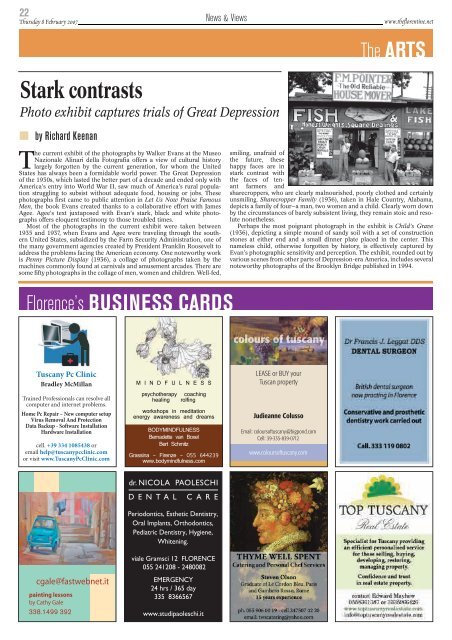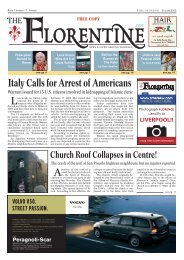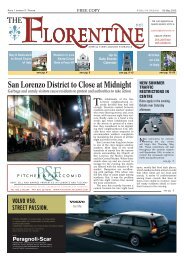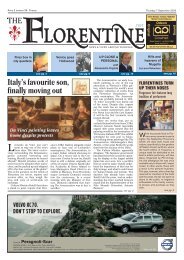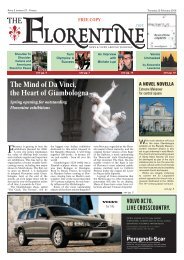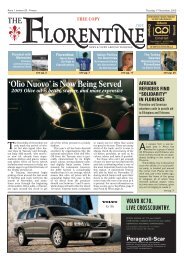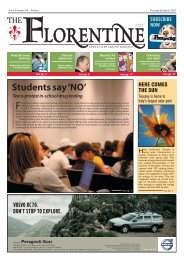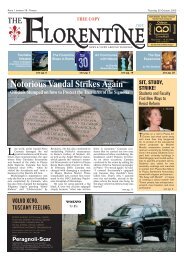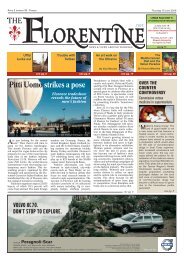Without the Arno, Florence would be like Romolo - The Florentine
Without the Arno, Florence would be like Romolo - The Florentine
Without the Arno, Florence would be like Romolo - The Florentine
Create successful ePaper yourself
Turn your PDF publications into a flip-book with our unique Google optimized e-Paper software.
22<br />
Thursday 8 February 2007<br />
�����������������<br />
����������������<br />
��������������������������������������<br />
�������������������������������<br />
�����������������������������������<br />
����������������������������<br />
�����������������������������������<br />
���������������������<br />
������������������������<br />
������������������������������<br />
���������������������������������<br />
News & Views<br />
Stark contrasts<br />
Photo exhibit captures trials of Great Depression<br />
by Richard Keenan<br />
<strong>The</strong> current exhibit of <strong>the</strong> photographs by Walker Evans at <strong>the</strong> Museo<br />
Nazionale Alinari della Fotografi a offers a view of cultural history<br />
largely forgotten by <strong>the</strong> current generation, for whom <strong>the</strong> United<br />
States has always <strong>be</strong>en a formidable world power. <strong>The</strong> Great Depression<br />
of <strong>the</strong> 1930s, which lasted <strong>the</strong> <strong>be</strong>tter part of a decade and ended only with<br />
America’s entry into World War II, saw much of America’s rural population<br />
struggling to subsist without adequate food, housing or jobs. <strong>The</strong>se<br />
photographs fi rst came to public attention in Let Us Now Praise Famous<br />
Men, <strong>the</strong> book Evans created thanks to a collaborative effort with James<br />
Agee. Agee’s text juxtaposed with Evan’s stark, black and white photographs<br />
offers eloquent testimony to those troubled times.<br />
Most of <strong>the</strong> photographs in <strong>the</strong> current exhibit were taken <strong>be</strong>tween<br />
1935 and 1937, when Evans and Agee were traveling through <strong>the</strong> sou<strong>the</strong>rn<br />
United States, subsidized by <strong>the</strong> Farm Security Administration, one of<br />
<strong>the</strong> many government agencies created by President Franklin Roosevelt to<br />
address <strong>the</strong> problems facing <strong>the</strong> American economy. One noteworthy work<br />
is Penny Picture Display (1936), a collage of photographs taken by <strong>the</strong><br />
machines commonly found at carnivals and amusement arcades. <strong>The</strong>re are<br />
some fi fty photographs in <strong>the</strong> collage of men, women and children. Well-fed,<br />
<strong>Florence</strong>’s BUSINESS CARDS<br />
cgale@fastwebnet.it<br />
painting lessons<br />
by Cathy Gale<br />
338.1499 392<br />
Periodontics, Es<strong>the</strong>tic Dentistry,<br />
Oral Implants, Orthodontics,<br />
Pediatric Dentistry, Hygiene,<br />
Whitening.<br />
viale Gramsci 12 FLORENCE<br />
055 241208 - 2480082<br />
EMERGENCY<br />
24 hrs / 365 day<br />
335 8366567<br />
www.studipaoleschi.it<br />
colours of tuscany<br />
LEASE or BUY your<br />
Tuscan property<br />
Judieanne Colusso<br />
Email: coloursoftuscany@bigpond.com<br />
Cell: 39-335-839-0712<br />
www.coloursoftuscany.com<br />
www.<strong>the</strong>fl orentine.net<br />
<strong>The</strong> ARTS<br />
smiling, unafraid of<br />
<strong>the</strong> future, <strong>the</strong>se<br />
happy faces are in<br />
stark contrast with<br />
<strong>the</strong> faces of tenant<br />
farmers and<br />
sharecroppers, who are clearly malnourished, poorly clo<strong>the</strong>d and certainly<br />
unsmiling. Sharecropper Family (1936), taken in Hale Country, Alabama,<br />
depicts a family of four—a man, two women and a child. Clearly worn down<br />
by <strong>the</strong> circumstances of barely subsistent living, <strong>the</strong>y remain stoic and resolute<br />
none<strong>the</strong>less.<br />
Perhaps <strong>the</strong> most poignant photograph in <strong>the</strong> exhibit is Child’s Grave<br />
(1936), depicting a simple mound of sandy soil with a set of construction<br />
stones at ei<strong>the</strong>r end and a small dinner plate placed in <strong>the</strong> center. This<br />
nameless child, o<strong>the</strong>rwise forgotten by history, is effectively captured by<br />
Evan’s photographic sensitivity and perception. <strong>The</strong> exhibit, rounded out by<br />
various scenes from o<strong>the</strong>r parts of Depression-era America, includes several<br />
noteworthy photographs of <strong>the</strong> Brooklyn Bridge published in 1994.


